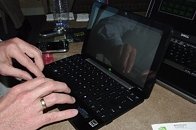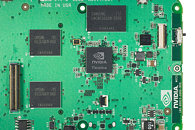Friday, April 3rd 2009

NVIDIA Tegra-based Mini-Notebook Spotted
It looks like NVIDIA's attempts to let Tegra make it to bigger platforms are beginning to bear fruit. LaptopMag got its hands on one of the first mini-notebooks based on Tegra, a fully-integrated computing architecture that focuses on making more powerful and visual portable computing devices possible. The Tegra CPU core is based on the ARM11 architecture, working along with NVIDIA's own graphics processing, and system controlling technologies.
The model in use with the mini-notebook is Tegra 650, which runs at 750 MHz (core clock speed), supports hardware HD video decoding, an S-Video out, and USB. It supports DDR memory running at 200 MHz, and an IDE channel for a sold-state drive for primary storage. Apart from the IDE interface, Tegra has its own NAND-flash controller so small amounts of flash memory (up to 8 GB) could be embedded onto the main PCB. The mini-notebook features an OS that lets the user achieve all the tasks one would ask from this 90~200 Dollar mini-notebook. Windows CE and Linux are the likely candidates. The screenshot below is that of the Windows CE-based prototype that takes advantage of the 3D processing power of the core. Also pictured is the prototype system board by NVIDIA.
Sources:
LaptopMag, Silicon Madness
The model in use with the mini-notebook is Tegra 650, which runs at 750 MHz (core clock speed), supports hardware HD video decoding, an S-Video out, and USB. It supports DDR memory running at 200 MHz, and an IDE channel for a sold-state drive for primary storage. Apart from the IDE interface, Tegra has its own NAND-flash controller so small amounts of flash memory (up to 8 GB) could be embedded onto the main PCB. The mini-notebook features an OS that lets the user achieve all the tasks one would ask from this 90~200 Dollar mini-notebook. Windows CE and Linux are the likely candidates. The screenshot below is that of the Windows CE-based prototype that takes advantage of the 3D processing power of the core. Also pictured is the prototype system board by NVIDIA.



36 Comments on NVIDIA Tegra-based Mini-Notebook Spotted
Translation: I just want it big enough so this doesn't happen. :roll:
I call it inefficient. It's just too small and too slow to be worth anything. The added value of spending an extra hundred bucks for a fully functional netbook with a proper Windows-based operating system is enormous.
And umm... Carrier subsidies? Only if they include WWAN cards, which are definitely not included in the aforementioned price. Something tells me someone pulled those numbers out of a hat...
New market segments pop up like crazy!
more graphical prowess for netbook architecture so people can enjoy games on this formfactor.
sure with a cpu that can handle it, but at what cost to power consumption...invalid ideas that work against the initial purpose of the netbook funddamental.
now look at this abortion of an ideea...lets pair our graphical prowess with a grossly underpowered cpu and power hungry slow old tech memory and run software that doesnt support the games that is our companies only in on this market....why would you buy this...it may have graphicly capable hardware butthe rest of the system will fail to support any gaming...FAIL is Nvidia...reduntant is thier ccause.
The Tegra was aimed towards mobile phones, smart phones ect. If my Blackberry could have the processing power these things have id be 20x more happier with it. It can barely play fuzzy quality Youtube videos and lags when going back and forth between certain screens. According to tests and benches the Tegra can play 1080p videos for hours and even play some Quake 3. Thats not to bad to me. Id love to have that in a phone.
OT; I've seen an Asus EEE with a 9300 GS built into it, 10" form factor; I wonder how it would stack up against the Tegra platform playing Quake III and other benchmarks...
I just hope intel IGP is going out and dies forever, im sure, if i ever gotta use a intel igp laptop again, ima gonna have nightmares :S
But back to the box itself, linux, wouldnt be a issue if its A64 clock for clock. is it ? doubt.
Via nano dualcore + 780G or GF 9400 is the key ! not ATOM.
Amd Neo is my suggestions to all of you guys who complain about the net-tops, or mini-notebook, or whatever they want to call them.
Im 180 CM tall, 70 kilograms, pretty skinny, but after i had to set up EEE's to a firm, that was one day barely touching them, still had to fix my neck and everything after, and almost got anger issues cause of the slowness of those boxes.
Neo is still slow, but its miles away from Atom slowness, and it feats a good enough graphics card for its size.
those come with 12-13 " displays and are rather small, but sitting on 9" is a nightmare, and looking at powerconsumtion, powerfull laptops: 95W
EEE Pc ~50W.
Wait, what? quadcore laptop with SLI/CF setup uses 45 W more... hmm ? battery capacity rumour about EEE is also false, i couldnt have it on longer than 4 hours, which i also did on a laptop rated 75 W 4 years ago. while playing flash which consumes power.
I see nothing special in mini laptops, other than their improved mobility.
Intel got chips thats good, but they aint in a nice platform that suits us i personally think.
The atom series isnt something im impressed by, they got the worst effeciency compared to both AMD and VIA, why not made the chip to run 2W hotter, dev a colder chipset, and voila lower power consumtion with 30% more performance straight away, noo, too hard :P
for business users this is amazing. to wirelessly/wired be able to transfer to display of your device to the 100" image on the wall that the rest of the people can see while you give your presentation is desirable. to be able to project your devices information on any surface is even better (no external display needed, you make your own).
gaming becomes even more a reality, you already have the portable device powerful enough to process the data, the device can have the controls, and you display externally on a display the same size as today's consoles use. for those that appreciate the success of the Nintendo Wii and it's controller evolution, you can imagine quite easily that the controller WAS the console, holding your smartphone with the device displaying wirelessly to a TV/monitor.
all the data is not a problem for devices that today already boast 8,16, and soon 32 gigs of storage.
it will become increasingly easy to have games, movies, business data/presentation,etc very capably on your device and be able to share it with who you want and how.
Intel may have made an effort with the Atom CPU, but they cobbled it together with a desktop motherboard setup that was so inneficient and underpowered that any return on the Atom investment was eroded by the rest of the platform.
Now Nvidia show their "Ion platform" and the difference is HUGE.
here are differences:
Intel's Atom netbook platform with CPU and chipset (Tegra shown also in this pic)=
here's Nvidia's Ion with Atom and GeForce 9400=
same functionality, vastly more efficient in every sense of space, energy consumption, performance.
I am unsure of your industry (nvidia sales rep?) but when at work i sure as hell am not walking around looking for compatable displays for my portable devices.
these presentations you speak of are are created at a company provided workstation or a notebook...not a bloody toy, I shyed away from such devices as soon as consumer handsets had decent PIM functions
because they arent a productive work medium